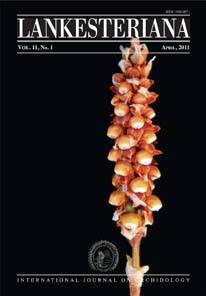Population structure of Oncidium poikilostalix (Orchidaceae), in coffee plantations in Soconusco, Chiapas, México
DOI:
https://doi.org/10.15517/lank.v11i1.18312Keywords:
Oncidium poikilostalix, micrositio, estadíos de vida, forofito, árbol de sombra, cafetoAbstract
We studied the population structure of Oncidium poikilostalix (Kraenzl.) M.W. Chase & N.H. Williams (Orchidaceae) newly reported for México in 2008 in the region of Soconusco (Chiapas state) in southeast Mexico, growing in shaded coffee plantations in two rural communities, Fracción Montecristo (FM) and Benito Juárez El Plan (BJ). In 2008-2009, we determined the characteristics of these coffee plantations, and the distribution of the various life stages (seedling, juvenile, adult) on the two phorophytes: coffee bushes (Coffea arabica L.) and shade trees (Inga micheliana Harms.). Principal Component Analysis and Discrimination Analysis were used to compare all the variables evaluated. There were 1123 individuals (82.63%) in FM and 236 (17.37%) in BJ. Of those, in FM 1060 individuals (94.4%) were epiphytic upon coffee bushes and 214 (91.06%) in BJ, the rest were epiphytic upon the shade trees (I. micheliana). Despite displaying the characteristics of a twig epiphyte, the preferred microsites of O. poikilostalix were the branches of the coffee bushes, with 703 individuals (55.18%) and the trunk of the shade trees, with 78 individuals (91.76%). More than a third of the population was juvenile stage (37.09%; 504 individuals). Oncidium poikilostalix probably entered México from Guatemala and appears to be a vigorous plant that is successfully adapting to its new sites of occupancy
Downloads
Downloads
Published
How to Cite
Issue
Section
License
According to the Open Access policy promoted by the University of Costa Rica, all the papers published by Lankesteriana are licensed under the Creative Commons copyright and can be downloaded free of charge. The journal holds copyright and publishing rights under the CC BY-NC-ND 3.0 CR license.
Before the publication of the materials submitted by the author(s) in LANKESTERIANA, the author(s) hereby assign all rights in the article to the Lankester Botanical Garden.





